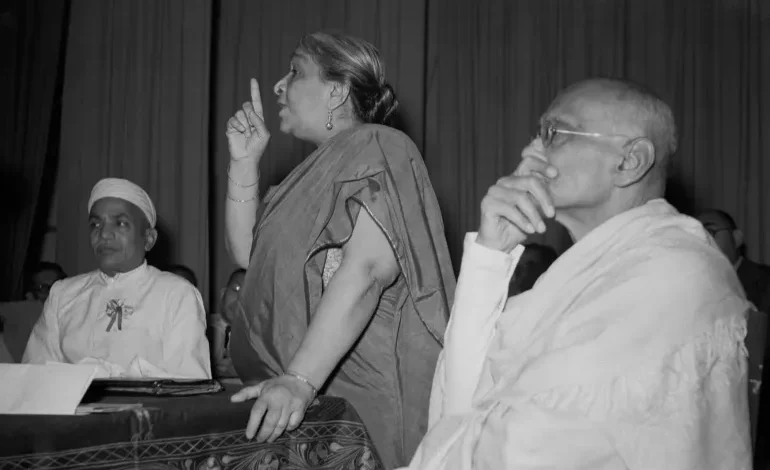The Indian poet who scared white South Africa – and changed it

One hundred years ago, on February 28, 1924, a four-foot-10-inch woman of colour gave a speech at the Wanderers Hall in Johannesburg. Despite speaking at the home of both rugby and cricket in the Transvaal province, she poured scorn on the British, writes historian Goolam Vahed, for thinking “they were the ‘masters’ and the Indians the ‘menials’.” She parodied the British attitude as follows: “We conquer, we rule, we trample down, we make graveyards where there were gardens, we rule with the iron heel, we flash the sword and daze the eyes of those who would look us in the face.”
And she ended with a warning. If the British thought they had successfully “fettered and manacled and trampled” Indians, this was “[their] illusion. In the end, the land goes back from the conquered to the true inheritors.”
Sarojini Naidu, the 45-year-old Indian poet-politician, had arrived in Johannesburg a few days earlier, via Kenya and Mozambique. She had come to protest Prime Minister Jan Smuts’s Class Areas Bill, which proposed “compulsory residential and trading segregation for Indians throughout South Africa.”
Nicknamed the Nightingale of India by her mentor and champion, Mahatma Gandhi, words did indeed tumble out of Naidu’s mouth for the duration of a two-month sojourn in which she addressed packed venues in all of South Africa’s main cities. But not everyone who heard them found them mellifluous. Despite being a dark-skinned visitor in a white man’s land, Naidu spoke her mind. And her ideas – regarding race, empire and women – were well ahead of their time.
While Naidu was vehement in her criticism of the Bill, she went to great pains to stress that South African Indians should oppose any legislation that discriminated on racial grounds, as historian Goolam Vahed has shown (PDF). The struggle in South Africa was, she said, “only one incident in the whole struggle which is taking place … Oppressed [Black] people of the world are linked together in the brotherhood of suffering and martyrdom”.
In Durban, a couple of weeks after she tried to mimic the British in the Johannesburg speech, Naidu spoke directly to Indian women: “I never hope to hear an Indian woman say, ‘I am different from the white women, the coloured women, the Native women’. I do not care what your religion is, you are women, and women were meant to lead the earth, and when women do that the world will become good. Do not think only of yourselves, but fight for your rights because you are women.”But 100 years after her visit, her dramatic impact on the country’s Black population – and in particular, its women – remains undiminished. Before Naidu’s visit, opposition politics was segregated along racial lines and almost exclusively male. After her visit, women took a leading role in opposition politics and people of different races began to work together in their struggle against the white minority government. As the Anglican missionary CF Andrews, a close friend of Gandhi’s, wrote, “Naidu’s visit has done one thing for which I bless her every day. She has finally cemented the Native cause with that of the Indian as one cause.”
Her influence on Cissie Gool, a young Muslim woman from Cape Town, was particularly important. As historians Patricia van der Spuy and Lindsay Clowes write, “It was what Naidu did – and what she told women to do – that was critical. Sarojini Naidu’s visit reveals a ‘light bulb’ moment for Cissie Gool, the realisation that women could inhabit the closely guarded citadel of ‘malestream’ politics, that gender need not stifle their political ambitions.”
Gandhi and the India-South Africa connection
In its first 180 years, colonial South Africa was heavily reliant on imported slave labour. The abolition of slavery in 1834 forced farmers to look elsewhere for unskilled workers. From 1860 onwards more than 150,000 indentured Indians would arrive in South Africa on five-year contracts, mainly to work on sugar cane plantations. These indentured labourers were treated badly, paid abysmally and granted zero political rights, but still about two-thirds of them made homes in South Africa after their contracts had expired. In addition to these indentured Indians, several thousand “passenger” Indians came to South Africa voluntarily – some of whom became successful businesspeople.
In 1893 a young Indian lawyer by the name of Mohandas (“Mahatma”) Gandhi arrived in South Africa to handle a legal matter for a wealthy Indian trader. The painfully shy young lawyer wore a three-piece suit and tie – coupled with a turban. Twenty-one years later, Gandhi left the country in the sandals and robes of an indentured labourer. But the changes were not only cosmetic. Gandhi arrived in South Africa an enthusiastic emissary of the empire and a racist. He left it an anti-imperialist and a supporter of Black unity. Even his policy of satyagraha or passive resistance was forged in South Africa.
South Africa – and particularly the injustices he witnessed there – had a profound impact on Gandhi’s politics. But he too made his mark on South African politics: the African National Congress – the party of Mandela, Sisulu and Tambo, which has just lost its grip on power in the 2024 elections – was in many ways inspired by Gandhi’s Indian National Congress, which has long since lost its grip on power in India.
Gandhi’s great woman disciple
By the time Sarojini Naidu arrived in South Africa, she was a seasoned politician with decades of public oratory under her belt. Born in Hyderabad in 1879, to a college principal father (who dabbled in science and poetry) and a singer mother (who dabbled in poetry) she qualified for university at the age of 12 and went on to study at King’s College in London and the University of Cambridge. While in the UK she got to know the renowned poetry critics Edmund Gosse and Arthur Symons, who helped her to hone her craft and develop a distinctly Indian voice.
Returning to Hyderabad in 1898 she married Govindaraju Naidu, a physician she’d met in England. Their inter-caste marriage was considered “groundbreaking and scandalous” by some, but both their families approved it. At the urging of the political reformer Gopal Krishna Gokhale, she launched her public speaking career in 1902. Her elegant addresses on topics like Indian independence, women’s rights and women’s education soon earned her invites to increasingly prominent political gatherings.
As journalist Nazma Yeasmeen Haque writes, “Sarojini Naidu’s early speeches, whether addressing students, women in general, purdanashin women [cloistered women who have almost no contact with the outside world], communities of Muslims [or] Hindus or any other religion were electrifying. She was a leader who inspired people and like a psychologist understood mass behaviour.”
Shortly after World War I broke out, in 1914, Naidu met Gandhi in London, and quickly became a fervent disciple of the “small, droll man” who, she said, “looked exactly like a bat”. The appreciation was mutual. As Vahed notes, “Gandhi wrote in Young India in 1920 that no praise of Naidu was ‘overdone … She has wonderful charm of manner and is tireless in her duties … God alone knows from where she gets the strength.’”
When, in 1924, Gandhi asked Naidu to visit South Africa as his emissary she could not refuse – even if it meant “leaving my little child who is dying because the needs of the children of our nation are greater than the needs of one child.” One of her sons was often ill.
The Gool in the crown of District 6
After addressing crowds in Johannesburg and Durban, Naidu headed south to Cape Town, the seat of South Africa’s parliament, to attend the debates around the Class Areas Bill. The white government pulled out all the stops to appease her: She travelled to Cape Town in a special train bearing her name and was garlanded wherever she went.
But instead of being numbed into silence, Naidu called out the special treatment, “When I am garlanded and given presents during my mission I realise that my people are indivisible whether born in India or being the children and grandchildren of the indentured labourers … Therefore, I must be full of sorrow and of shame because I, too, being of my people, soul of their soul, blood of their blood, bone of their bone, am a helot and slave standing before you, though you garland me.”
While in Cape Town, it was assumed that Naidu would stay where Gandhi always stayed in the Mother City: with a wealthy Indian trader called Yusuf Gool. But Gool’s daughter-in-law, Zainunissa ‘Cissie’ Gool “put her foot down” and insisted that Naidu stay with her. Van der Spuy and Clowes argue that the three weeks Naidu spent in Gool’s home were crucial in Cissie’s political development.
Born in 1897, to Dr Abdullah Abdurahman and his Scottish wife Nellie James, Cissie Gool had a lot in common with Sarojini Naidu. She grew up in “the most prestigious mansion in the whole of District Six”, a mixed-race suburb that was famously bulldozed by the apartheid government in the 1970s, and, due to her father’s position at the helm of the African Political Organisation, was exposed to the ideas of many leading liberals – including Gandhi – during her childhood.
Gool, like Naidu, excelled academically. She was the first woman of colour to enrol at the University of Cape Town and had a way with words: She won a literary competition when she was just fifteen years old. But when Naidu visited in 1924, Gool had not so much as contemplated a career in politics.
Gool’s father may have been ahead of his time when it came to educating women, but he was also a staunch patriarch who hadn’t yet acknowledged that women had much role to play politically. Her mother was a more progressive role model, but even she restricted her activities to the Women’s Guild of the African Political Organisation (APO). Naidu, however, had no qualms about wading into the male world of politics – in fact, she seemed to relish it.
Gool made a point of attending all of Naidu’s Cape Town speeches, and she was clearly awestruck. When the Cape Times misogynistically accused Naidu of “emotional, ill balanced harangues”, Gool could maintain her silence no longer. In her letter to the editor, which was published on April 1, 1924, Gool wrote that the paper’s “virulent attack” on Naidu compelled her to give her “impression of her speeches and the good work she has done” while in South Africa:









